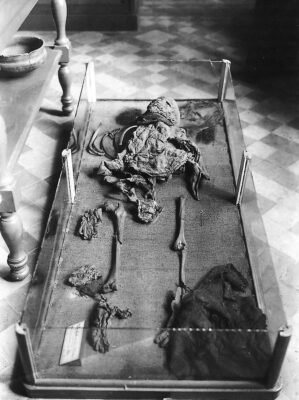History - The Yde Girl of The Netherlands
Yde Girl - facial reconstruction at Drents Museum
I had never heard of the ‘Yde girl’ until I’d listened to the Blackbriar song, ‘Fairy of the Bog’ (video below).
Reading the lyrics, which are helpfully provided in the ‘description box’ below the video, I was intrigued by these lines:
‘I was an offering to the gods
And turned into the lady of the bog
My body was found in Yde
So that is now my name
Displayed in a museum…’
I then looked it up and discovered the song was inspired by the fate of a real girl.
The village of Yde is in the Netherlands.
On the 12th of May 1897, while digging up peat from the Stijfveen peat bog, located near Yde, peat-cutters stumbled across a body with blackened face and red hair.
Terrified, they fled, returning later to hide the body.
Days later, the body was found and news of it spread to the village.
Yde Girl at Drents Museum (Wikimedia Commons)
The preserved body had long red hair and was covered in a woollen cloak with a braided band of material wrapped around her neck three times like a noose.
There was also a stab wound near her collarbone.
It was believed she’d either been executed or sacrificed.
The Yde girl’s skin and features were well-preserved as are most bog bodies because lack of oxygen prevents bacteria from breaking down the tissue; the tannic acid in the marsh water also helps to preserve the bodies.
Carbon-14, or radiocarbon, dating, suggests she lived between 54BC and 128AD, so she died in the 1st century.
A CT scan suggests she was about 16 when she died. The scan showed a lack of wisdom teeth, meaning she died before they appeared.
Although her hair was red when found, scientists believe this was caused by the chemicals in the bog and that she was actually blonde.
About 1.4m (just under 5ft) tall, the Yde girl had scoliosis – her spine curved the wrong way.
This would have caused her to place more of her body weight on one side, and scans showed she had a swollen right foot.
Sadly, her well-preserved state had been damaged by the peat-cutters’ tools, and villagers had pulled out some of her hair, teeth, and bones before museum authorities removed her.
She was taken to the provincial museum in Assen where Dr Willem Pleyte, an archaeologist from the Rijksmuseum (the national archaeological museum of the Netherlands) in Leiden, was the first to study her.
He wanted the Yde girl to be taken to the museum in Leiden, but the museum in Assen wanted to keep her body there, in the province that had been her home.
In 1992, a British expert in forensic facial reconstruction, Richard Neave of Manchester University, made a reconstruction of the Yde girl’s head using criminal pathology techniques.
As to her fate, she lived during the Celtic era and it would appear that human sacrifice featured in their religious practices.
It was often the case that disabled people were chosen, probably because they were viewed as being of little use to the tribe.
Yde girl’s scoliosis would have affected her mobility, so it’s very likely her tribe saw her as more of a burden, and that could have been the reason she was chosen for sacrifice.
Drents Museum in Assen, which has the largest collection of bog bodies in the world, is where Yde girl can be found.
A sign at the location of the discovery of her body tells her story.
Location where the bog girl of Yde was found (Ruud Zwart - Wikimedia Commons)
Nothing is known of her family, her tribe or how much she suffered before her death; one can only hope her end was quick.



